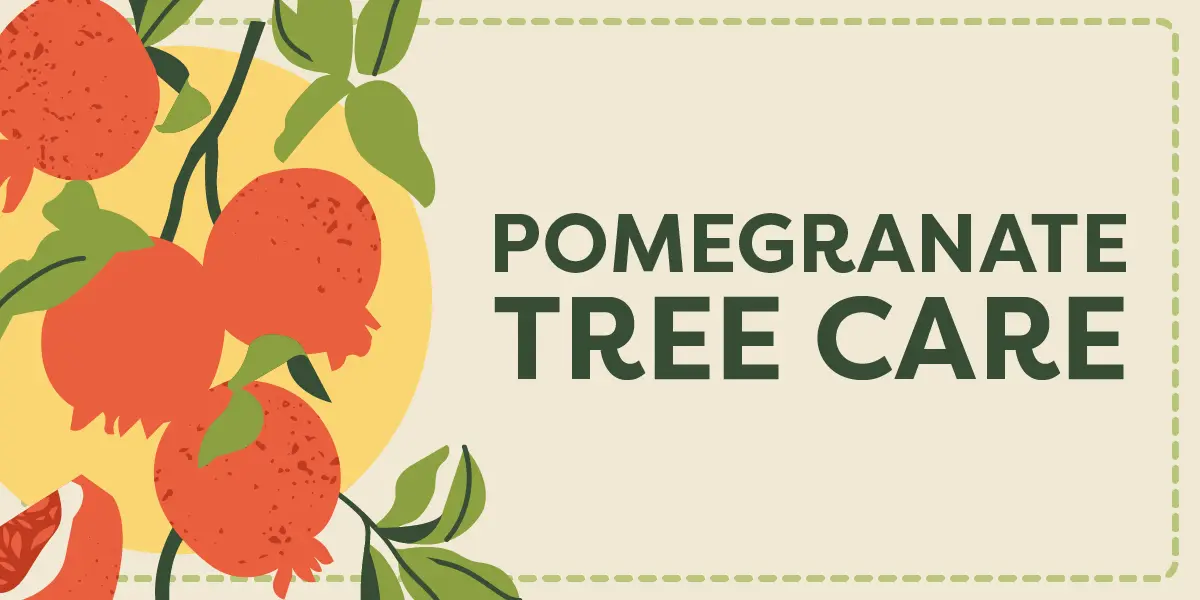To the ancient Persians, the pomegranate represented fertility and abundance. In Greek mythology, the pomegranate symbolized prosperity and eternal life.
The fruit is a powerhouse of health benefits — rich in antioxidants like punicalagin and anthocyanins, which reduce inflammation and boost cardiovascular health. It’s an excellent source of vitamins C, K, potassium, fiber, and protein.
The trees are tailor-made for Southern California’s warm, arid climate. With proper care, they’ll produce showy blossoms every spring and a bountiful harvest of ruby-red fruit in the fall.
Selecting a Pomegranate Tree
Some pomegranate varieties do poorly in hot or dry climates, while others are vulnerable to disease in certain soil types. The varieties best suited for Southern California include:
- Wonderful has large, sweet fruit and vibrant red skin. It’s highly productive and drought-tolerant.
- Angel Red is a high-yield variety produces juicy, sweet fruit with a deep red color and is resistant to cracking.
- Parfianka is exceptionally flavorful and sweet, bearing a gorgeous display of flowers in addition to its fruit.
- Pink Satin features pale pink fruit with a soft, juicy texture and relatively low acidity.
- Sweet is prized for its sweet flavor and easy-to-peel fruit.
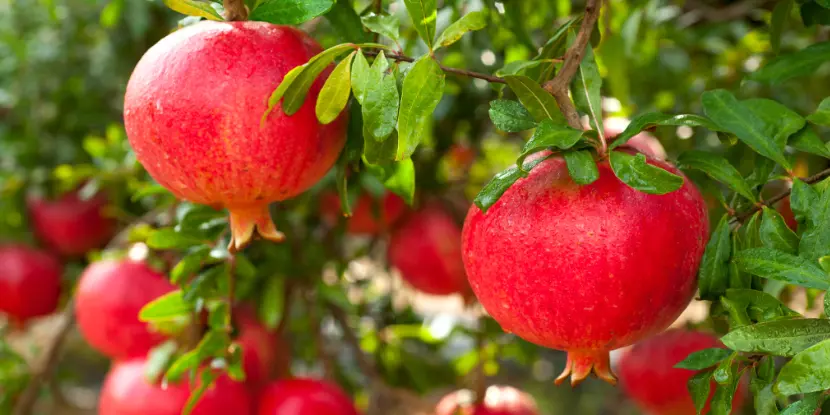
Ripe pomegranate fruit hanging from the branches of a tree.
Soil Preferences
- Sandy loam allows for good drainage while retaining essential moisture.
- Acidic to slightly alkaline soil is optimal (pH of 5.5 to 7.0).
- Incorporating organic matter, such as compost or well-rotted manure, enhances soil fertility and moisture retention.
- Moderate levels of nutrients, particularly nitrogen, phosphorus, and potassium, encourage productive growth and fruit yield.
- Pomegranate trees are sensitive to salinity. Conduct a soil test to ensure that salinity levels are low.
Light Requirements
- Pomegranate trees should receive at least 6 to 8 hours of direct sunlight daily.
- A south-facing location is ideal.
- Insufficient light can lead to poor flowering and reduced fruit set. Excessive shade can increase the risk of disease.
- In areas with intense sun, provide some afternoon shade during the hottest months to prevent leaf scorch.
- Monitor the tree’s growth: healthy leaves should be vibrant and glossy.
Temperature
- Pomegranate trees prefer a temperature range of 60°F to 95°F (15°C to 35°C).
- They tolerate short periods of temperatures as low as 12°F (-11°C), but prolonged exposure to frost will damage the tree and fruit.
- Ideal temperatures remain above 50°F (10°C) during the growing season.
- Temperatures above 75°F (24°C) during fruit maturity can benefit sweetness and quality.
- Avoid planting in areas exposed to extreme temperature fluctuations.
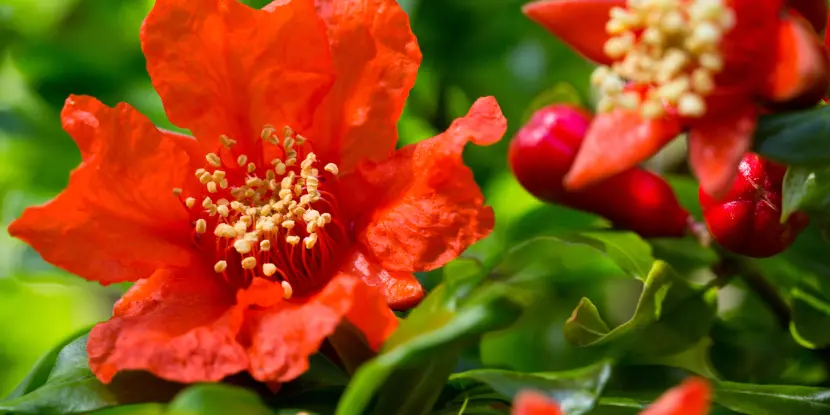
The brilliant red flowers of a pomegranate tree.
Planting Your Pomegranate Tree
- Choose a spot with full sun, well-draining soil, and good air circulation. Avoid locations where water collects, or roots may be disturbed by other plants or structures.
- The best time for planting is late winter or early spring when the soil is moist and temperatures are mild.
- Dig a hole twice as wide and deep as your tree’s root ball. Mix in compost or organic matter to improve drainage and fertility.
- Place your tree in the hole. The top of the root ball should be level with the surrounding soil. Backfill and gently firm the soil around the roots.
- Water thoroughly after planting, and continue to water deeply once a week during the first year to establish a healthy root system.
Watering & Fertilizing
Watering
- Pomegranate trees require regular watering, especially during dry spells or while the fruit develops. However, they’re drought-tolerant and don’t like soggy soil.
- Established trees in well-draining soil should receive deep watering (1.5 to 2 feet deep) every 7–10 days during hot weather.
- Young trees may need more frequent watering until their root systems are mature.
- Reduce watering in the fall to promote fruit ripening and harden off new growth before winter.
Fertilizing
- Fertilize pomegranate trees annually in late winter or early spring with a balanced fertilizer, following package instructions for application rates.
- Avoid high-nitrogen fertilizers, which can cause excessive leaf growth at the expense of fruit production.
- Excessive fertilizer can lead to overgrown trees more susceptible to pests and diseases.
Pruning & Pest Control
Pruning
- Prune pomegranate trees in late winter or early spring when they’re still dormant.
- Remove any damaged, dead, or crossing branches. Trim back overgrowth to maintain a balanced shape and encourage fruiting.
- Make clean cuts just above a bud facing outward from the tree’s center.
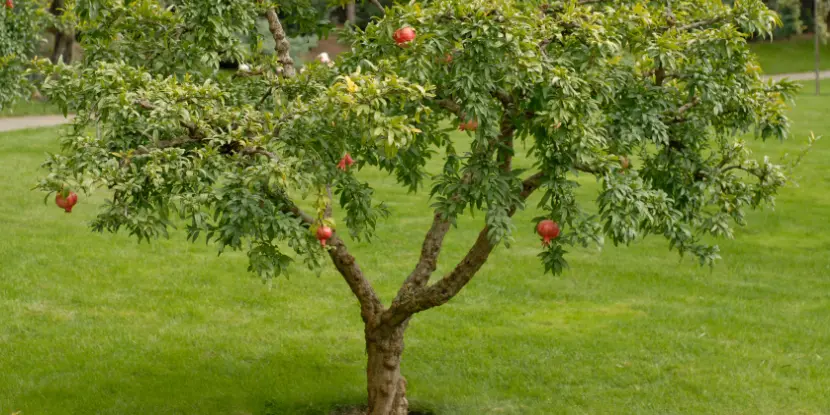
A well-shaped pomegranate tree.
Pest Control
- Caterpillars, leaf-footed bugs, and fruit flies may target pomegranates.
- Keep the area around the tree free of debris and weeds to discourage pests.
- Monitor for signs of infestation, such as holes in leaves or fruit, and apply insecticidal soap or other natural remedies.
Harvesting & Storage
- Pomegranates are ready for harvest when the skin changes from green to yellow, red, or pink (depending on the variety) and is shiny. The fruit should feel heavy for its size and make a metallic sound when tapped.
- Cut the pomegranates off the tree with scissors or shears. Avoid pulling them off by hand, which can damage the tree.
- Store ripe fruit in a cool, dry place or refrigerate for up to two months.
- Pomegranates can be eaten fresh, juiced, or used in cooking and baking. The seeds (or arils) can be frozen or dried for later use.
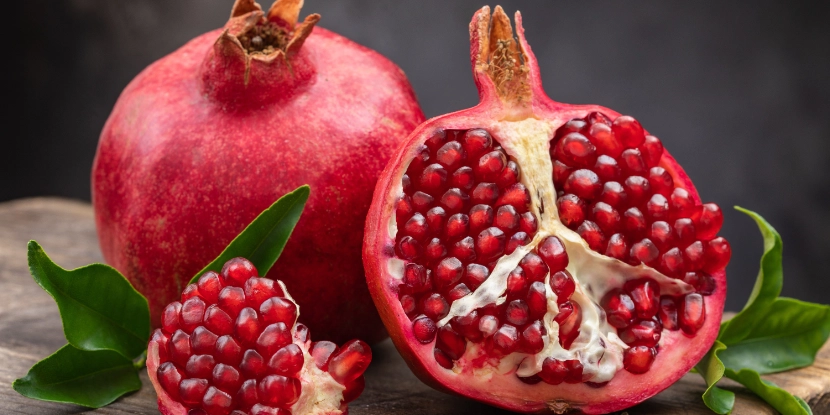
The seeds, or arils, of a pomegranate.
FAQs: Growing Pomegranate Trees
Q: How often should I water my pomegranate tree?
Water young trees about once a week during the growing season. Mature trees are more drought-tolerant but still benefit from regular watering, especially during hot, dry periods.
Q: When will my pomegranate tree start producing fruit?
Pomegranate trees typically bear fruit 3–4 years after planting. The fruit quality improves as the tree matures.
Q: Can I grow pomegranates in containers?
Pomegranates can be grown in large containers. Ensure the pot has good drainage and uses a well-draining potting mix. Container-grown trees may require more frequent watering and fertilizing.
Q: What is the best climate for growing pomegranates?
Pomegranates thrive in warm, arid to semi-arid climates. They prefer temperatures between 70°F and 85°F (21°C and 29°C) during the growing season and can tolerate short periods of frost, but sustained freezing temperatures can damage the tree.
Q: How should I protect my pomegranate tree during winter?
In colder regions, mulch around the tree’s base, which helps insulate the roots. For young or container-grown trees, consider bringing them indoors or to a sheltered location during freezing spells.
Q: Can pomegranate trees self-pollinate?
Pomegranate trees are self-pollinating, meaning they can produce fruit without a second variety for cross-pollination. However, having multiple trees can enhance yields.
Q: What are the signs of overwatering my pomegranate tree?
Symptoms include yellowing leaves, wilting, and a general decline in health. The roots may become rot-prone, leading to the tree’s eventual death. Ensuring well-drained soil can help prevent these issues.
Q: Do pomegranate trees have pest or disease-resistant varieties?
- ‘Grenada’ resists root-knot nematodes.
- ‘Wonderful’ has good resistance to fungal diseases and pests.
- ‘Sweet’ tolerates bacterial blight.
However, no pomegranate tree variety is immune to all pests and diseases. Proper care is essential.

